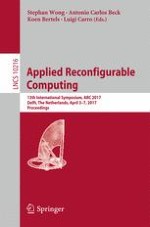2017 | Buch
Applied Reconfigurable Computing
13th International Symposium, ARC 2017, Delft, The Netherlands, April 3-7, 2017, Proceedings
herausgegeben von: Stephan Wong, Antonio Carlos Beck, Koen Bertels, Luigi Carro
Verlag: Springer International Publishing
Buchreihe : Lecture Notes in Computer Science
